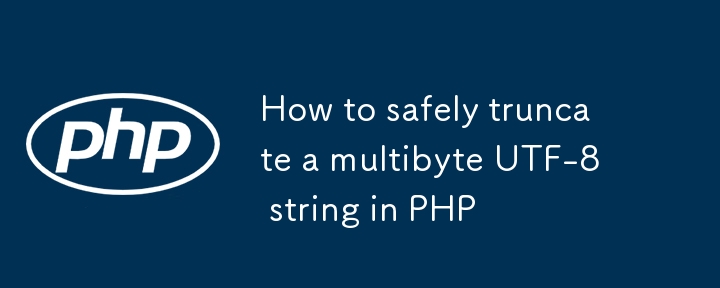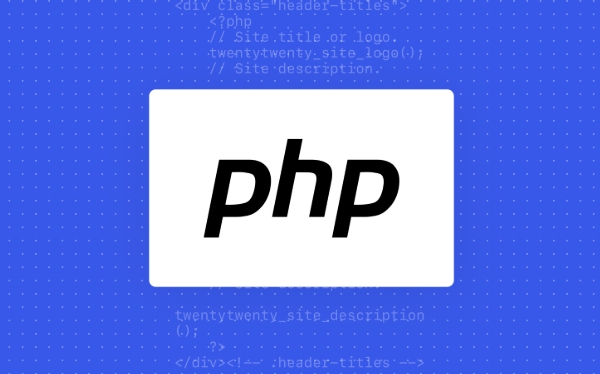To safely shorten a UTF-8 string in PHP with multibyte characters, use mbstring functions like mb_substr() with explicit UTF-8 encoding instead of substr(), avoid falling back unless input is ASCII-only, handle byte-length truncation carefully by backtracking to valid UTF-8 boundaries using functions like safe_truncate_bytes(), and for visual integrity, consider grapheme_substr() from the Intl extension for handling grapheme clusters such as emojis with modifiers.

When you need to shorten a UTF-8 string in PHP, especially one that might contain multibyte characters like emojis or characters from non-Latin alphabets (e.g., Chinese, Japanese, Cyrillic), doing it the wrong way can result in broken characters or invalid strings. The key is to use functions that understand multibyte encodings rather than assuming each character is a single byte.

Use mbstring Functions Instead of Default String Functions
PHP’s default string manipulation functions like substr() assume each character is exactly one byte, which isn’t true for many UTF-8 characters. For example, an emoji like ? takes up 4 bytes in UTF-8. Using substr() on such a string could cut it off mid-byte-sequence and leave you with garbage.
Instead, always use the mb_ prefixed functions from the mbstring extension, particularly mb_substr():

mb_substr($text, 0, $length, 'UTF-8');
Make sure to specify 'UTF-8' as the encoding parameter — don't rely on defaults, especially if your code might run in different environments.
- Always check if
mbstringis enabled usingfunction_exists('mb_substr')- Avoid falling back to
substr()unless you're certain the input is ASCII-only
Be Careful with Byte Length vs Character Length
Sometimes, you might want to truncate based on byte size instead of character count — for example, when storing data in a field with a byte limit. In that case, you have to be extra cautious not to split multibyte sequences.

One safe approach is to start truncating at a byte position slightly below your limit and then backtrack until you find a valid UTF-8 start byte:
function safe_truncate_bytes($str, $maxBytes) {
if (strlen($str) <= $maxBytes) return $str;
$head = substr($str, 0, $maxBytes);
$lastValidPos = mb_strlen($head, 'UTF-8');
while ($lastValidPos > 0) {
$candidate = mb_substr($str, 0, $lastValidPos, 'UTF-8');
if (mb_check_encoding($candidate, 'UTF-8')) {
return $candidate;
}
$lastValidPos--;
}
return '';
}This ensures that even if you cut off part of a multibyte character, you roll back to the last complete character.
Handle Edge Cases Like Emojis and Grapheme Clusters
Even with mb_substr(), there are cases where what appears to be one character is actually made up of multiple Unicode code points — for example, skin tone modifiers or flag emojis. These aren't handled correctly by mbstring.
If you really need to preserve visual character integrity (like cutting by visible graphemes), consider using the Intl extension and grapheme_substr():
if (function_exists('grapheme_substr')) {
$shortened = grapheme_substr($text, 0, $charLimit);
}This is more accurate for user-facing display truncation but comes with heavier dependencies.
So yes, safely truncating a UTF-8 string in PHP involves more than just slicing it. It means respecting multibyte boundaries, being aware of encoding, and sometimes thinking about how characters are visually composed. Once you get these basics right, it's not too bad — just make sure you test with some real-world examples like emojis, accented letters, and non-Latin scripts.
The above is the detailed content of How to safely truncate a multibyte UTF-8 string in PHP. For more information, please follow other related articles on the PHP Chinese website!

Hot AI Tools

Undress AI Tool
Undress images for free

Undresser.AI Undress
AI-powered app for creating realistic nude photos

AI Clothes Remover
Online AI tool for removing clothes from photos.

Clothoff.io
AI clothes remover

Video Face Swap
Swap faces in any video effortlessly with our completely free AI face swap tool!

Hot Article

Hot Tools

Notepad++7.3.1
Easy-to-use and free code editor

SublimeText3 Chinese version
Chinese version, very easy to use

Zend Studio 13.0.1
Powerful PHP integrated development environment

Dreamweaver CS6
Visual web development tools

SublimeText3 Mac version
God-level code editing software (SublimeText3)
 PHP Variable Scope Explained
Jul 17, 2025 am 04:16 AM
PHP Variable Scope Explained
Jul 17, 2025 am 04:16 AM
Common problems and solutions for PHP variable scope include: 1. The global variable cannot be accessed within the function, and it needs to be passed in using the global keyword or parameter; 2. The static variable is declared with static, and it is only initialized once and the value is maintained between multiple calls; 3. Hyperglobal variables such as $_GET and $_POST can be used directly in any scope, but you need to pay attention to safe filtering; 4. Anonymous functions need to introduce parent scope variables through the use keyword, and when modifying external variables, you need to pass a reference. Mastering these rules can help avoid errors and improve code stability.
 How to handle File Uploads securely in PHP?
Jul 08, 2025 am 02:37 AM
How to handle File Uploads securely in PHP?
Jul 08, 2025 am 02:37 AM
To safely handle PHP file uploads, you need to verify the source and type, control the file name and path, set server restrictions, and process media files twice. 1. Verify the upload source to prevent CSRF through token and detect the real MIME type through finfo_file using whitelist control; 2. Rename the file to a random string and determine the extension to store it in a non-Web directory according to the detection type; 3. PHP configuration limits the upload size and temporary directory Nginx/Apache prohibits access to the upload directory; 4. The GD library resaves the pictures to clear potential malicious data.
 Commenting Out Code in PHP
Jul 18, 2025 am 04:57 AM
Commenting Out Code in PHP
Jul 18, 2025 am 04:57 AM
There are three common methods for PHP comment code: 1. Use // or # to block one line of code, and it is recommended to use //; 2. Use /.../ to wrap code blocks with multiple lines, which cannot be nested but can be crossed; 3. Combination skills comments such as using /if(){}/ to control logic blocks, or to improve efficiency with editor shortcut keys, you should pay attention to closing symbols and avoid nesting when using them.
 Tips for Writing PHP Comments
Jul 18, 2025 am 04:51 AM
Tips for Writing PHP Comments
Jul 18, 2025 am 04:51 AM
The key to writing PHP comments is to clarify the purpose and specifications. Comments should explain "why" rather than "what was done", avoiding redundancy or too simplicity. 1. Use a unified format, such as docblock (/*/) for class and method descriptions to improve readability and tool compatibility; 2. Emphasize the reasons behind the logic, such as why JS jumps need to be output manually; 3. Add an overview description before complex code, describe the process in steps, and help understand the overall idea; 4. Use TODO and FIXME rationally to mark to-do items and problems to facilitate subsequent tracking and collaboration. Good annotations can reduce communication costs and improve code maintenance efficiency.
 How Do Generators Work in PHP?
Jul 11, 2025 am 03:12 AM
How Do Generators Work in PHP?
Jul 11, 2025 am 03:12 AM
AgeneratorinPHPisamemory-efficientwaytoiterateoverlargedatasetsbyyieldingvaluesoneatatimeinsteadofreturningthemallatonce.1.Generatorsusetheyieldkeywordtoproducevaluesondemand,reducingmemoryusage.2.Theyareusefulforhandlingbigloops,readinglargefiles,or
 Learning PHP: A Beginner's Guide
Jul 18, 2025 am 04:54 AM
Learning PHP: A Beginner's Guide
Jul 18, 2025 am 04:54 AM
TolearnPHPeffectively,startbysettingupalocalserverenvironmentusingtoolslikeXAMPPandacodeeditorlikeVSCode.1)InstallXAMPPforApache,MySQL,andPHP.2)Useacodeeditorforsyntaxsupport.3)TestyoursetupwithasimplePHPfile.Next,learnPHPbasicsincludingvariables,ech
 How to access a character in a string by index in PHP
Jul 12, 2025 am 03:15 AM
How to access a character in a string by index in PHP
Jul 12, 2025 am 03:15 AM
In PHP, you can use square brackets or curly braces to obtain string specific index characters, but square brackets are recommended; the index starts from 0, and the access outside the range returns a null value and cannot be assigned a value; mb_substr is required to handle multi-byte characters. For example: $str="hello";echo$str[0]; output h; and Chinese characters such as mb_substr($str,1,1) need to obtain the correct result; in actual applications, the length of the string should be checked before looping, dynamic strings need to be verified for validity, and multilingual projects recommend using multi-byte security functions uniformly.
 Quick PHP Installation Tutorial
Jul 18, 2025 am 04:52 AM
Quick PHP Installation Tutorial
Jul 18, 2025 am 04:52 AM
ToinstallPHPquickly,useXAMPPonWindowsorHomebrewonmacOS.1.OnWindows,downloadandinstallXAMPP,selectcomponents,startApache,andplacefilesinhtdocs.2.Alternatively,manuallyinstallPHPfromphp.netandsetupaserverlikeApache.3.OnmacOS,installHomebrew,thenrun'bre






